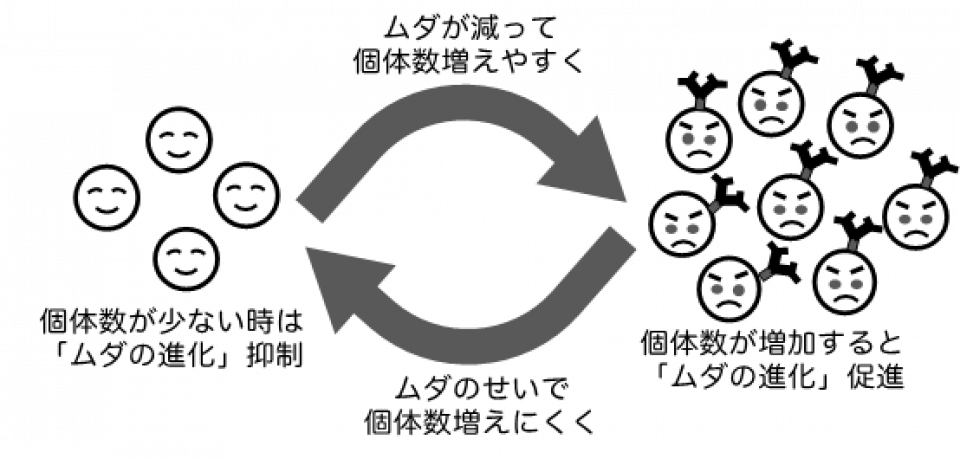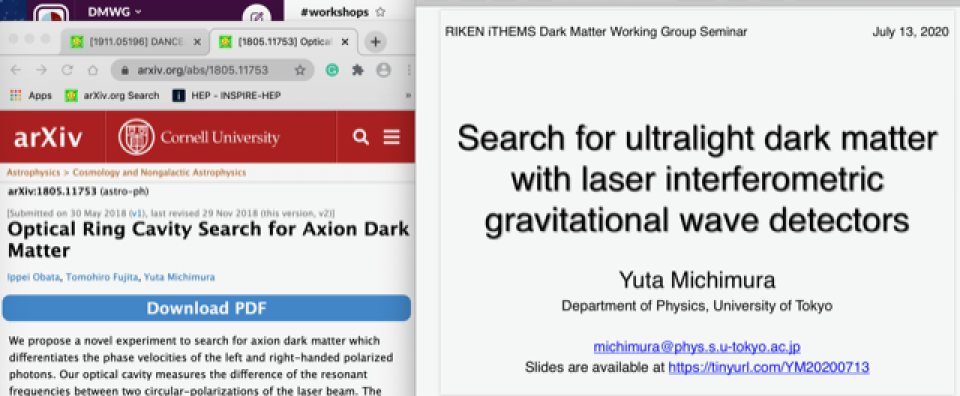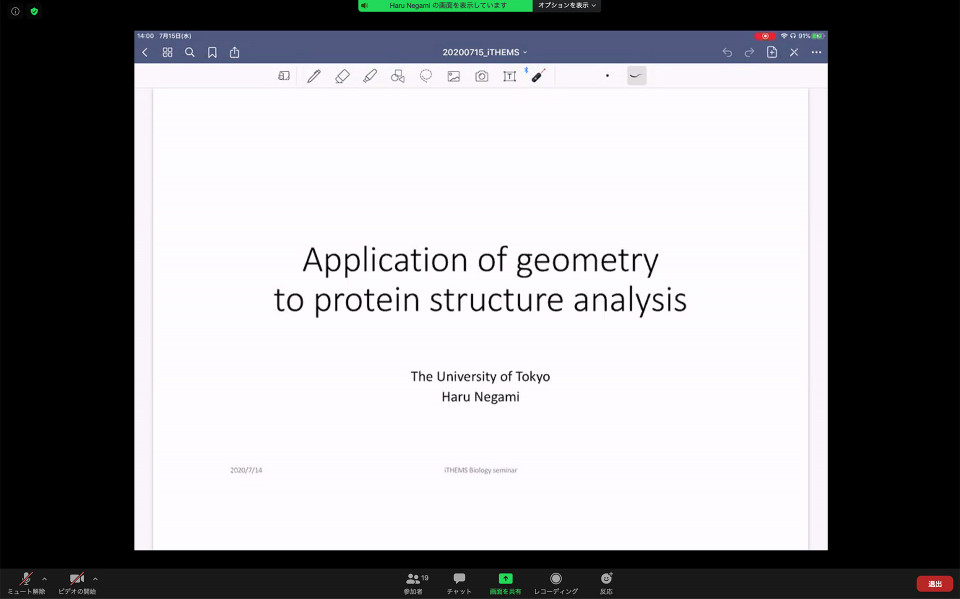Volume 112
Back to Newsletter List
Press Release
When adaptation promotes coexistence
2020-07-10
Peafowl males have prominent ornaments, birds song for courtship, and flowers are beautiful and attractive for pollen transporters. Such characteristics appear to be adaptive at the level of individuals, but do not necessarily increase population growth rate. Therefore, these are, at the level of species, “wasteful”, making the species weaker to other species in competition for resources. Our collaboration group named this process as “intra-specific adaptation load,” and developed mathematical models, showing that strong intra-specific competition leads to a coexistence of a number of species that would have otherwise excluded each other (“competitive exclusion”). This new mechanism, which has been rarely considered in biodiversity research, may actually play a pivotal role in maintaining the biodiversity on earth.
Reference
- Masato Yamamichi, Daisuke Kyogoku, Ryosuke Iritani, Kazuya Kobayashi, Yuma Takahashi, Kaori Tsurui-Sato, Akira Yamawo, Shigeto Dobata, Kazuki Tsuji, Michio Kondoh, Intraspecific Adaptation Load: A Mechanism for Species Coexistence, Trends in Ecology & Evolution 35 (10) 897-907 (2020), doi: 10.1016/j.tree.2020.05.011
Seminar Report
DMWG seminar on July 13 by Dr. Michimura
2020-07-16
The Michelson interferometer is sensitive to the new physics as well as to the gravitational wave. The input laser beam is split in the horizontal and vertical direction, then combined again after times of the round trip in the cavity of each path. The patters of the interference give us the information about the change in path length, forces shifting the reflecting mirrors, and/or the change in the speed of light. During the observing run searching for the gravitational waves, a high-intensity laser form the input source is supplied continuously so it is highly efficient if we can make use of the laser to probe other physics simultaneously.
Let us focus on the laser beams after the split. The polarization of the split laser beam changes at each time it is reflected. When axion (or axion-like particle, ALP) coupled to photon exists, the velocity of the right- and left-handed polarized waves should be different. Hence by setting the "bow-tie" cavity to realize different path-length for the right- and left-handed polarized photons, we should see the signature of the ALP in the interference pattern.
This idea, which is proposed by Dr. Michimura and his colleagues, is completely new and enable us to probe the unexplored region for ALP lighter than ~0.1 micro-eV. Furthermore, this new search can be done during the gravitational-wave observations and do not affect such observations. He also has shown the expected sensitivity for scalar and vector DM picking up well-motivated examples and told us another idea for the experiment. Such new ideas should open new ways to access the nature of dark matter!
Search for ultralight dark matter with laser interferometric gravitational wave detectors
July 13 (Mon) 10:00 - 11:00, 2020
Seminar Report
Biology Seminar about "Application of geometry to protein structure analysis" on July 15, 2020
2020-07-16
In Biology Seminar on 15th July, a graduate student Haru Oono-Negami (Engineering department, University of Tokyo) talked about a general overview of the interdisciplinary topic between geometry and protein biology, as well as her own work on the protein-classification algorithms based on topological properties. Understanding and predicting the function of structurally "similar" proteins is of pivotal importance to any field of biology. Her work extends previous studies that classify the topological structure of proteins in a computationally reasonable time still with a good accuracy. We audience, after her talk, excitedly discussed extensions and background problems behind her talk. Thank you so much for the great talk, Haru-san!
- Ryosuke Iritani
Application of geometry to protein structure analysis
July 15 (Wed) 14:00 - 15:00, 2020
Upcoming Events
Colloquium
MACS ColloquiumSupported by iTHEMSSUURI-COOL (Kyoto)
The 12nd MACS Colloquium
July 17 (Fri) 15:00 - 18:30, 2020
Yasuaki Hiraoka (Professor, Kyoto University Institute for Advanced Study (KUIAS) / Team Leader, Topological Data Analysis Team, RIKEN Center for Advanced Intelligence Project (AIP))
Motomu Tanaka (Professor, Physical Chemistry of Biosystems, Heidelberg University, Germany / Professor, Center for Integrative Medicine and Physics, Kyoto University Institute for Advanced Study (KUIAS))
15:00- Talk by Prof. Yasuaki Hiraoka
16:15- MACS Student Conference FY2020
17:30- Talk by Prof. Motomu Tanaka
Venue: via Zoom
Event Official Language: Japanese
Seminar
iTHEMS Biology Seminar
Human Time vs. Mouse Time in Embryonic Development
July 17 (Fri) 16:00 - 17:00, 2020
Miki Ebisuya (Group Leader, European Molecular Biology Laboratory, Barcelona, Spain)
Different species have different tempos of development: larger animals tend to grow more slowly than smaller animals. My group has been trying to understand the molecular basis of this interspecies difference in developmental time, using the segmentation clock as a model system.
The segmentation clock is the oscillatory gene expressions that regulate the timing of body segment formation during early embryogenesis. We have recently succeeded in recapitulating the segmentation clock from both human and mouse pluripotent stem cells, detecting oscillations and traveling waves in vitro. Interestingly, the oscillation period of human segmentation clock was 5-6 hours while that of mouse was 2-3 hours. Taking advantage of our in vitro system and simple mathematical models, we have been comparing the genome sequences and molecular processes of the segmentation clock between human and mouse to explain the interspecies difference in the oscillation period.
References
- Matsuda et al., “Species-specific oscillation periods of human and mouse segmentation clocks are due to cell autonomous differences in biochemical reaction parameters”, bioRxiv, doi.org/10.1101/650648 (2019)
- Matsuda et al., “Recapitulating the human segmentation clock with pluripotent stem cells”, Nature, 580 (2020)
Venue: via Zoom
Event Official Language: English
Seminar
DMWG Seminar
DMWG special seminar : “The result of the XENON1T experiment and its implications”
July 22 (Wed) 15:30 - 17:00, 2020
Masaki Yamashita (Associate Professor, Cosmic-ray Research Division, Institute for Space–Earth Environmental Research, Nagoya University)
Venue: via Zoom
Event Official Language: Japanese
If you would like to cancel your subscription or change your email address,
please let us know via our contact form.
Copyright © iTHEMS, RIKEN. All rights reserved.






